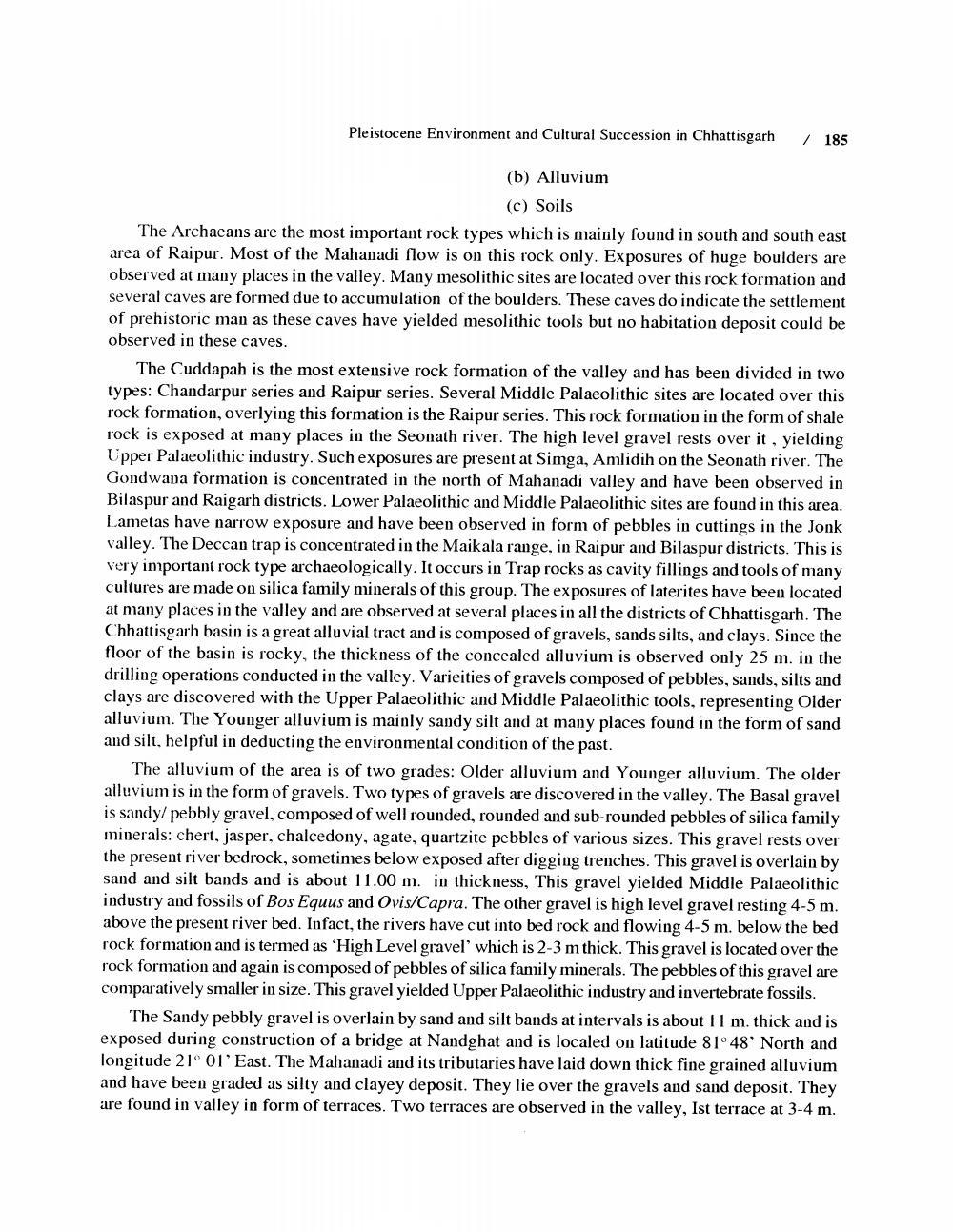________________
Pleistocene Environment and Cultural Succession in Chhattisgarh
(b) Alluvium (c) Soils
/ 185
The Archaeans are the most important rock types which is mainly found in south and south east area of Raipur. Most of the Mahanadi flow is on this rock only. Exposures of huge boulders are observed at many places in the valley. Many mesolithic sites are located over this rock formation and several caves are formed due to accumulation of the boulders. These caves do indicate the settlement of prehistoric man as these caves have yielded mesolithic tools but no habitation deposit could be observed in these caves.
The Cuddapah is the most extensive rock formation of the valley and has been divided in two types: Chandarpur series and Raipur series. Several Middle Palaeolithic sites are located over this rock formation, overlying this formation is the Raipur series. This rock formation in the form of shale rock is exposed at many places in the Seonath river. The high level gravel rests over it, yielding Upper Palaeolithic industry. Such exposures are present at Simga, Amlidih on the Seonath river. The Gondwana formation is concentrated in the north of Mahanadi valley and have been observed in Bilaspur and Raigarh districts. Lower Palaeolithic and Middle Palaeolithic sites are found in this area. Lametas have narrow exposure and have been observed in form of pebbles in cuttings in the Jonk valley. The Deccan trap is concentrated in the Maikala range, in Raipur and Bilaspur districts. This is very important rock type archaeologically. It occurs in Trap rocks as cavity fillings and tools of many cultures are made on silica family minerals of this group. The exposures of laterites have been located at many places in the valley and are observed at several places in all the districts of Chhattisgarh. The Chhattisgarh basin is a great alluvial tract and is composed of gravels, sands silts, and clays. Since the floor of the basin is rocky, the thickness of the concealed alluvium is observed only 25 m. in the drilling operations conducted in the valley. Varieities of gravels composed of pebbles, sands, silts and clays are discovered with the Upper Palaeolithic and Middle Palaeolithic tools, representing Older alluvium. The Younger alluvium is mainly sandy silt and at many places found in the form of sand and silt, helpful in deducting the environmental condition of the past.
The alluvium of the area is of two grades: Older alluvium and Younger alluvium. The older alluvium is in the form of gravels. Two types of gravels are discovered in the valley. The Basal gravel is sandy/ pebbly gravel, composed of well rounded, rounded and sub-rounded pebbles of silica family minerals: chert, jasper, chalcedony, agate, quartzite pebbles of various sizes. This gravel rests over the present river bedrock, sometimes below exposed after digging trenches. This gravel is overlain by sand and silt bands and is about 11.00 m. in thickness, This gravel yielded Middle Palaeolithic industry and fossils of Bos Equus and Ovis/Capra. The other gravel is high level gravel resting 4-5 m. above the present river bed. Infact, the rivers have cut into bed rock and flowing 4-5 m. below the bed rock formation and is termed as 'High Level gravel' which is 2-3 m thick. This gravel is located over the rock formation and again is composed of pebbles of silica family minerals. The pebbles of this gravel are comparatively smaller in size. This gravel yielded Upper Palaeolithic industry and invertebrate fossils.
The Sandy pebbly gravel is overlain by sand and silt bands at intervals is about II m. thick and is exposed during construction of a bridge at Nandghat and is localed on latitude 81°48' North and longitude 21° 01' East. The Mahanadi and its tributaries have laid down thick fine grained alluvium and have been graded as silty and clayey deposit. They lie over the gravels and sand deposit. They are found in valley in form of terraces. Two terraces are observed in the valley, Ist terrace at 3-4 m.




